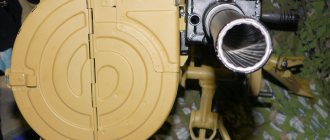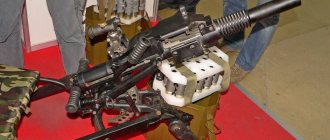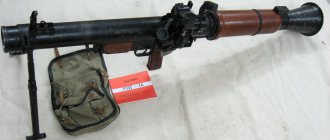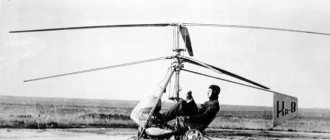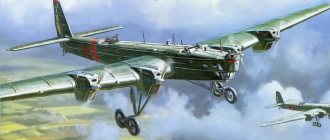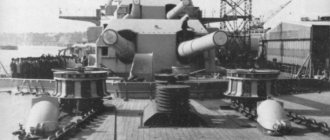German grenade launchers "Panzerschrek" and "Ofenror" "Panzerschrek" is a German reusable hand-held anti-tank grenade launcher from the Second World War. It appeared in service with the German army in 1944 and proved to be a very effective means of combating Allied armored vehicles. Translated into Russian, “Panzerschrek” means “horror of tanks.”
During the war, the Germans created a huge number of new types of weapons, some of which can easily be called breakthrough. Guided anti-tank missiles, cluster munitions, jet aircraft, ballistic and cruise missiles... The list goes on. But German grenade launchers - like the Panzerschreck, Ofenror or the famous Faustpatron - are one of the few examples of direct copying from foreign models.
"Panzerschrek" and "Ofenror" at the museum stand
An example for German designers was the American M1 Bazooka, first used in North Africa. Although, having borrowed the very principle of operation and the design of the weapon, the Germans introduced a lot of new things into the design of grenade launchers.
The Panzerschreck is, in fact, an improved modification of another anti-tank weapon - the German Ofenror grenade launcher. The main difference between the Panzerschreck and the base model was the presence of a shield that protected the shooter from the exhaust gases of the rocket.
During serial production in Germany, more than 314 thousand Panzerschrecks and more than 2.2 million missiles for them were produced. That is, for each grenade launcher there were only seven rockets.
The Panzerschreck was a very powerful anti-tank weapon; its main disadvantages were its relatively large weight and bulkiness. In addition, these weapons cannot be called cheap and easy to produce. The Panzerschreck was used both on the Eastern and Western Fronts, it was in service with Wehrmacht units, and later these grenade launchers began to be supplied to Volksturm units.
"Panzerschrek" was used on the Eastern and Western Fronts
History of the Panzerschreck
The most famous grenade launcher of World War II is, without a doubt, the Faustpatron. The American Bazooka M1 is somewhat inferior to it in terms of “popularity”. However, attempts to create light portable recoilless rifles were made much earlier. In 1916, the Russian engineer Ryabushinsky created a recoilless gun that fired over-caliber shells. However, at that time there was simply no purpose for this weapon: there were few tanks, and such a weapon was not very effective against infantry.
In 1931, a 65-mm Petropavlovsky jet gun was created, which was never put into service. There were other attempts to use recoilless rifles to combat armored vehicles, the importance of which grew from year to year.
Just before the start of the war, the Soviet Union managed to create new models of tanks, with a powerful power plant and ballistic armor - the T-34 and KV. The appearance of these vehicles on the battlefield was an extremely unpleasant surprise for the Germans. The most popular German anti-tank gun, the Pak 35/36, did not penetrate the armor of new Soviet tanks even from minimal distances, for which it received the nickname “beater” among Wehrmacht soldiers. In addition, the Nazis were shocked by the total number of armored vehicles that the Red Army had.
German grenade launcher in combat conditions
An effective means of combating Soviet armored vehicles was the 88-mm FlaK anti-aircraft gun, but it could not always cover the infantry everywhere, and these guns were quite expensive.
The general situation with anti-tank defense in the German army was very accurately and succinctly described by the officer of the German General Staff, Eick Middeldorf: “... anti-tank defense is, without a doubt, the saddest chapter in the history of the German infantry... Apparently, it will remain completely unknown why for two years from the appearance of the T-34 tank in June 1941 until November 1943, no acceptable anti-tank infantry weapon was created.”
This problem became especially acute for the Wehrmacht in the second half of the war, when the Allies' advantage in armored vehicles became overwhelming. The Germans needed a new anti-tank weapon, simple and effective, which would be characterized by sufficient mobility. Therefore, the new American weapon became a real godsend for them.
German reports have been preserved about the capture of several American Bazooka grenade launchers and missiles for them during the fighting in North Africa. This weapon fired 60mm rockets and could penetrate 80mm of tank armor. However, this was not enough to successfully fight heavy Soviet tanks.
To create their own analogue of the Bazooka, the Germans took a more powerful cumulative ammunition with a caliber of 88 mm, which was used for the Raketenwerfer 43 launcher. The launcher was developed by Hugo Schneider Aktien-Gesellschaft from Leipzig, and the rocket was developed by Westfaelisch-Anhaltische Sprengstoff AG from Reinsdorf. In May 1943, tests of pre-production grenade launcher samples began, they were quite successful, and already in October the new weapon was sent to the front.
At a distance of 150 meters, the missile penetrated 210 mm of armor
The characteristics of the new anti-tank weapon were very impressive: at a range of 150 meters, the missile penetrated 210 mm of armor along the normal line and 160 mm at an angle of 40 degrees. The grenade launcher was designated Raketenpanzerbuchse 43 (RPzB.43), but German soldiers nicknamed it Ofenrohr, which means “smoke stack.” Under this name it usually appears in various historical literature. “Ofenror” weighed only 9.5 kg, which made it possible to use this weapon directly in infantry combat formations.
In October 1943, Ofenror reached the Eastern Front. The first experience of using a grenade launcher was considered successful: now German infantry could effectively resist almost any type of Soviet tank, and hit them at distances of 100-150 meters. However, quite serious shortcomings of the new weapon were also revealed, the main one of which was the danger to the grenade launcher himself during the launch of the rocket. The jet of hot exhaust gases could easily cause injury, even if precautions were taken. The gunner's fear of getting burned seriously reduced shooting accuracy. When using Ofenror, the grenade launcher had to wear a gas mask without a filter and fireproof gloves.
Soldier with grenade launcher
In addition, the barrel of the Ofenror quickly burned out; it was enough for 300-350 shots. It was also noted that the exhaust seriously unmasks the positions of the crew and can injure their own soldiers who accidentally ended up behind the grenade launcher. The military also had complaints about the sighting devices of the grenade launcher.
In general, the practical use of Ofenror showed the significant potential of this weapon, but at the same time the need for its improvement became obvious.
In August 1944, the troops began to receive a modernized version of the grenade launcher, which received its own name RPzB. 54 Panzerschrek. The main difference from the Ofenror was the appearance in the design of the grenade launcher of a lightweight removable shield, which protected the shooter from the effects of hot gases. A small hole was made in the shield, covered with glass, through which aiming took place. The weapon kit included a set of spare glasses.
Also, significant changes were made to the design of sighting devices. It has become more convenient to fire at moving targets from the Panzerschreck. The position of the front sight could be adjusted even for air temperature, which significantly increased the accuracy of the weapon.
"Panzerschrek" is ready to fire
After the start of mass serial production of the Ofenrorov and Panzerschrecks, changes were made to the field regulations of the German army. Now they were ordered to create in each infantry company one anti-tank platoon, armed with six grenade launchers. In 1944, most of the Panzerschrecks were sent to the Western Front, to Italy, France and Belgium. These weapons significantly increased the firepower of German infantry divisions. At the end of the war, Ofenrors, Panzerschrecks and various types of Faustpatrons formed the backbone of the anti-tank defense of German units.
Anti-tank weapons of the German infantry (part 2)
Soon after Germany's attack on the Soviet Union, it became clear that the anti-tank rifles at the disposal of the Wehrmacht were of limited effectiveness against light tanks and completely unsuitable for combating medium T-34s and heavy KVs.
In this regard, the German infantry, as in the First World War, was forced to use improvised means: bunches of grenades, engineering bombs with explosives and mines. Bundles usually used 5-7 Stielhandgranate 24 (M-24) grenade casings, attached to a grenade with a handle using a belt belt, wire or rope. Moreover, each grenade contained 180 g of explosives; most often, the “mallets” were equipped with surrogates based on ammonium nitrate. Bunch of M-24 grenades
According to German instructions, it was recommended to throw a bunch of grenades under the chassis, or, jumping onto the tank, place it under the rear niche of the tank turret, and then activate the grating fuse. It is clear that this method of destroying armored vehicles was extremely risky for those who dared to do it.
In a similar way, but much less frequently, TNT and melinite 100-200 g bombs were used against tanks, combined in bundles of 5-10 pieces and equipped with a rope loop or wooden handle, as well as 1 kg Sprengbüchse 24 engineering ammunition (German Explosive charge model 1924 of the year). It could be thrown up to 20 m using a handle on the outside of the waterproof box.
German engineering ammunition Sprengbüchse 24 with a detonator installed in a socket, equipped with a fire cord and igniter ANZ-29
Sprengbüchse 24 was a stick of explosive (TNT or picric acid) in a waterproof zinc or steel container with a carrying handle and three holes for detonators. When used as a hand-held anti-tank mine, standard ANZ-29 igniters were used to ignite a 10-15 mm long fire cord. Also, when installing the DZ-35 pressure fuse, 1 kg charges could be placed under the tracks of tanks.
In addition to their own grenades and engineering ammunition, the German infantry used captured Soviet RGD-33 grenades, of which more than 300 thousand units were captured in the initial period of the war, to make anti-tank munitions. The RGD-33 was adopted by the Wehrmacht under the designation Handgranate 337 (r) and was actively used until 1943. In addition, the Germans did not shy away from using incendiary fluid bottles on the Eastern Front, although of course on a smaller scale than in the Red Army.
As for anti-tank mines, in the initial period of the war they were used quite limitedly. However, it was envisaged that Tellermine 35 (T.Mi.35) anti-tank mines with a pressure fuse could be pulled under the chassis of tanks moving perpendicular to the fire cells and infantry trenches using a rope or telephone wire.
To combat armored vehicles and long-term firing points in Germany at the end of the 30s, a cumulative mine Panzerhandmine (German: Hand-held anti-tank mine) was designed, which was attached to the armor using a felt pad impregnated with an adhesive composition. During storage and transportation, the adhesive surface was covered with a protective cover.
Panzerhandmine cumulative mine
Inside the mine weighing 430 g contained 205 g of a mixture of TNT and ammonium nitrate and a tetryl detonator weighing 15 g. The main charge had a cumulative funnel with a steel lining and was capable of piercing 50 mm of armor along the normal line. Panzerhandmine was equipped with a standard grating fuse from a hand grenade, with a deceleration time of 4.5-7 s. Theoretically, a mine could be thrown at a target like a hand grenade, but there was no guarantee that it would hit the target with its head and stick to the armor.
Real combat experience has demonstrated the insufficient armor penetration of an adhesive mine and the impossibility of attaching it to a dusty or wet surface. In this regard, at the beginning of 1942, a more advanced bottle-shaped Panzerhandmine 3 (PHM 3) with an aluminum alloy body was adopted.
Magnetic anti-tank mine Panzerhandmine 3
Unlike the earlier model, this ammunition was attached to the armor using magnets. In addition, Panzerhandmine 3 was additionally equipped with a metal ring with spikes for attaching the mine to a wooden surface. At the neck of the mine there was a fabric loop for hanging on a belt. Panzerhandmine 3 was equipped with a standard fuse and detonator cap from the Eihandgranaten 39 (M-39) hand grenade with a delay of 7 s. Compared to the “sticky mine,” the magnetic mine became much heavier, its weight reached 3 kg, and the mass of the explosive was 1000 g. At the same time, armor penetration increased to 120 mm, which already made it possible to penetrate the frontal armor of heavy tanks.
The bottle-shaped magnetic mine was soon replaced in production by a mine known as the Hafthohlladung 3 or HHL 3 (German: Attachable Shaped Charge). With armor penetration increased to 140 mm, this ammunition was simpler and cheaper to produce.
Magnetic anti-tank mine Hafthohlladung 3
The body of the new mine was a tin funnel with a handle attached to a getinax plate, to the bottom of which were attached three powerful magnets, closed during transportation with a safety ring. In preparation for combat use, a fuse from a hand grenade with a slowdown of 4.5-7 s was placed in the handle. The magnets withstood a force of 40 kg. The mass of the mine itself was 3 kg, of which half was explosive.
Hafthohlladung 3 magnetic mine device
1 – Explosive. 2 – Handle. 3 – Detonator socket. 4 – Thread for grating fuse. 5 – Placement of the fuse. 6 – Magnet mounting bolts. 7 – Getenaks plate. 8 – Magnets.
In mid-1943, the improved Hafthohlladung 5 (HHL 5) appeared. Changes made to the shape of the cumulative funnel and an increase in the mass of the explosive to 1700 g made it possible to penetrate 150 mm of armor or 500 mm of concrete. At the same time, the mass of the modernized mine was 3.5 kg.
German soldier with a magnetic anti-tank mine
Sufficiently high armor penetration and the ability to be installed on armor at right angles, regardless of the shape of the armored hull, made it possible to overcome the protection of any Soviet tank used during the Second World War. However, in practice, the use of HHL 3/5 has been difficult and associated with great risk.
Installing a magnetic mine on the side armor of a tank
In order to attach a magnetic mine to vulnerable areas of moving armored vehicles, it was necessary to leave a trench or other shelter and approach the tank closely, and after installing the mine on the armor, initiate the fuse. Considering that the zone of continuous destruction by shrapnel during the explosion was approximately 10 m, the tank destroyer had little chance of surviving. The infantryman required enormous courage and readiness for self-sacrifice. A German soldier had the opportunity to lay a mine without exposing himself to mortal danger only in areas with shelter, during combat operations in the city, or against a tank that had lost its mobility and was not covered by its own infantry. However, magnetic mines were produced in significant quantities. In 1942-1944. More than 550 thousand HHL 3/5 cumulative ammunition were produced, which were used in combat until the last days of the war.
In addition to anti-tank magnetic mines, the German infantry were armed with cumulative hand grenades Panzerwurfmine 1-L (PWM 1-L). Literally the name of the grenade can be translated as: Hand-held anti-tank mine. This ammunition was created in 1943 by order of the Luftwaffe to arm paratroopers, but was later actively used by the Wehrmacht.
The Panzerwurfmine 1-L cumulative grenade next to the Stielhandgranate 24 fragmentation grenade.
The grenade had a teardrop-shaped tin body to which a wooden handle was attached. A spring-loaded fabric stabilizer was placed on the handle, which opened after removing the safety cap during a throw. One of the stabilizer springs moved the inertial fuse to the firing position. A grenade weighing 1.4 kg was loaded with 525 g of TNT alloy with hexogen and at an angle of 60° could penetrate 130 mm of armor; when meeting armor at a right angle, the armor penetration was 150 mm. After exposure to a cumulative jet, a hole with a diameter of about 30 mm was formed in the armor, and the damaging effect behind the armor was very significant.
Although after throwing a cumulative grenade, the range of which did not exceed 20 m, it was necessary to immediately take cover in a trench or behind an obstacle protecting from fragments and a shock wave, in general the PWM 1-L turned out to be safer to use than magnetic mines.
In 1943, more than 200 thousand hand anti-tank grenades were transferred to the troops, most of them went to units on the Eastern Front. Experience in combat use demonstrated that the cumulative warhead is sufficiently effective against the armor of medium and heavy tanks, but soldiers noted that the grenade was too long and inconvenient to use. Soon the shortened Panzerwurfmine Kz (PWM Kz) was launched into production, which had the same warhead as its predecessor PWM 1-L.
Anti-tank hand grenade PWM Kz
In the modernized PWM Kz grenade, the design of the stabilizer was changed. Stabilization was now provided by a canvas band that pulled out from the handle when throwing. At the same time, the length of the grenade was reduced from 530 to 330 mm, and the weight became less by 400 g. Due to the reduction in weight and dimensions, the throwing range increased by about 5 m. In general, the PWM Kz was a fairly successful anti-tank ammunition, guaranteeing the ability to penetrate the armor of all existing serial tanks at that time. This is confirmed by the fact that on the basis of PWM Kz in the USSR in the second half of 1943, the RPG-6 anti-tank grenade was quickly created, which, like PWM Kz, was used until the end of hostilities.
Hand-thrown anti-tank grenades and cumulative magnetic mines became widespread in the armed forces of Nazi Germany. But at the same time, the German command was well aware of the risks associated with using anti-tank “weapons of last chance” and sought to equip the infantry with anti-tank weapons that minimized the risk of personnel being damaged by shrapnel and shock waves and did not require leaving cover.
Since 1939, the German infantry's anti-tank arsenal has had the Gewehr Panzergranate 30 (G.Pzgr.30) 30-mm cumulative rifle grenade. The grenade was fired from a mortar mounted on the muzzle of a standard 7.92 mm Mauser 98k carbine using a blank cartridge with smokeless powder. The maximum firing range at an elevation angle of 45° exceeded 200 m. Sighting range - no more than 40 m.
Gewehr Panzergranate 30 cumulative rifle grenade
To stabilize the grenade in flight, in its tail there was a belt with ready-made rifling, which coincided with the rifled part of the mortar. The head of the grenade was made of tin, and the tail was made of soft aluminum alloy. In the head part there was a cumulative funnel and a TNT charge weighing 32 g, and in the rear part there was a detonator capsule and a bottom fuse. The grenades, along with exploding cartridges, were delivered to the troops fully equipped, in cases made of pressed cardboard impregnated with paraffin.
A German infantryman loads a 30mm rifle grenade
The G.Pzgr.30 cumulative grenade, weighing about 250 g, could penetrate 30 mm of armor normally, which made it possible to fight only light tanks and armored vehicles. Therefore, in 1942, the “large” rifle grenade Grosse Gewehrpanzergranate (gr. G. Pzgr.) with an over-caliber warhead entered service. A reinforced cartridge with a sleeve with an elongated muzzle and a wooden bullet, which gave the grenade additional momentum when fired, was used as an expulsion charge. At the same time, the recoil became significantly higher, and the shooter’s shoulder could withstand no more than 2-3 shots in a row without the risk of injury.
Grosse Gewehrpanzergranate (gr. G. Pzgr.) cumulative rifle grenade
The weight of the grenade increased to 380 g, while its body contained 120 g of TNT alloy with hexogen in a 50/50 ratio. The declared armor penetration was 70 mm, and the maximum firing range from a rifle grenade launcher was 125 m.
Soon after the appearance of gr. G. Pzgr received a grenade with a reinforced tail section, designed for firing from the GzB-39 grenade launcher, which was created on the basis of the PzB-39 anti-tank rifle. When converted into a grenade launcher, the PTR barrel was shortened, a muzzle attachment for shooting rifle grenades and new sights were installed on it. Like the anti-tank rifle, PzB-39, the GzB-39 grenade launcher had a bipod folding in the stowed position and a metal butt turning down and forward. To carry the grenade launcher, a handle attached to the weapon was used.
Grenade launcher GzB-39
Due to greater strength and better stability, the accuracy of fire from a grenade launcher was higher than from rifle mortars. Effective fire on moving targets was possible at a distance of up to 75 m, and on stationary targets - up to 125 m. The initial speed of the grenade was 65 m/s.
Although the armor penetration of a rifle grenade gr. The G. Pzgr theoretically made it possible to fight T-34 medium tanks; its destructive effect if the armor was penetrated was small. At the beginning of 1943, on the basis of the Grosse Gewehrpanzergranate grenade, a large 46-mm gun armor-piercing grenade Gewehrpanzergranate 46 (G. Pzgr. 46) with improved efficiency was developed. Thanks to an increase in the mass of explosives in the cumulative warhead to 155 g, the armor penetration of the G. Pzgr. 46 was 80 mm. However, this was not enough for the Germans and soon the Gewehrpanzergranate 61 (G. Pzgr. 61) grenade, which had an increased warhead length and diameter, entered service. The mass of the 61-mm grenade was 520 g, and its warhead contained a 200 g explosive charge, which made it possible to penetrate 110 mm of armor plate at a right angle.
Below - rifle grenade Gewehrpanzergranate 46. Above - Gewehrpanzergranate 61
The new grenades could be fired from a rifle mortar attached to the muzzle of a rifle, but in practice, due to the very strong recoil, it was difficult to fire more than one shot at the shoulder. In this regard, it was recommended to rest the butt of the rifle against the wall of the trench or the ground, but this reduced the shooting accuracy, and it was almost impossible to hit a moving target. For this reason, G. Pzgr. grenades. 46 and G. Pzgr. 61 were mainly used to fire the GzB-39 grenade launcher. According to reference data, the maximum firing range from the grenade launcher was 150 m, which, apparently, became possible thanks to the use of a reinforced expelling cartridge. Until the advent of rocket-propelled grenade launchers, the GzB-39 remained the most powerful and long-range German infantry anti-tank weapon used in the platoon-company unit.
In 1940, the Luftwaffe adopted the 61-mm rifle grenade Gewehrgranate zur Panzerbekämpfung 40 or GG/P-40 (German Anti-tank rifle grenade) for parachute units.
GG/P-40 cumulative rifle grenade
The GG/P-40 grenade, using a blank cartridge and a muzzle attachment equipped with a grenade launcher sight, could be fired not only from Mauser 98k carbines, but also from FG-42 automatic rifles. The initial speed of the grenade was 55 m/s. Stabilization in flight was carried out by a six-blade tail at the end of the tail, where the inertial fuse was also located.
A rifle cumulative grenade, weighing 550 g, with an improved warhead loaded with a RDX charge weighing 175 g, provided armor penetration up to 70 mm. The maximum firing range was 275 m, the sighting range was 70 m. In addition to the possibility of hitting armored targets, this ammunition had a good fragmentation effect. Although the GG/P-40 rifle grenade at the time of its appearance had good combat characteristics, fairly high reliability, a simple design and was inexpensive to produce, in the initial period of the war it did not gain much popularity due to contradictions between the command of the Wehrmacht and the Luftwaffe. After 1942, due to the increase in tank protection, it was considered obsolete.
In addition to rifle grenades, “pistol” cumulative grenades were used to fire at armored vehicles. The grenades were fired from a standard 26-mm rocket launcher with a smooth barrel or from the Kampfpistole and Sturmpistole grenade launcher systems, which were created on the basis of single-shot signal pistols with a breakable barrel and a hammer-type impact mechanism. Initially, 26-mm Leuchtpistole signal pistols designed by Walter arr. were adapted for firing fragmentation and cumulative grenades. 1928 or mod. 1934.
Flare pistol Leuchtpistole 34
The 326 H/LP shot, based on the 326 LP fragmentation grenade, was a finned cumulative projectile with a contact fuse, connected to an aluminum sleeve that contained a propellant charge.
26-mm “pistol” grenade Wurfkorper 326 Leuchtpistole (326 LP)
Although the maximum firing range exceeded 250 m, effective fire with a cumulative grenade was possible at a distance of no more than 50 m. Due to the small caliber of the cumulative grenade, it contained only 15 g of explosive, and armor penetration did not exceed 20 mm.
Due to low armor penetration, when hit by a “pistol” cumulative grenade, it was often not possible to stop even light tanks with bulletproof armor. In this regard, based on 26-mm signal pistols, a Kampfpistole grenade launcher with a rifled barrel was created, designed to shoot over-caliber grenades, in the head of which it was possible to place a larger explosive charge. A new graduated sight and spirit level were attached to the left side of the pistol body. At the same time, the rifled barrel did not allow the use of either 326 LP and 326 H/LP pistol grenades, or signal and lighting cartridges adopted for 26-mm rocket launchers.
Panzerwnrfkorper 42 LP cumulative grenade
The 61-mm Panzerwnrfkorper 42 LP (PWK 42 LP) grenade had a mass of 600 g and consisted of an over-caliber head and a rod with ready-made rifling. The cumulative warhead contained 185 g of TNT alloy with hexogen. Its armor penetration was 80 mm, but its effective firing range was no more than 50 m.
A German infantryman with a Sturmpistole pistol grenade launcher loaded with a PWK 42 LP cumulative grenade.
Due to the significant mass of the projectile and the correspondingly increased recoil, the Sturmpistole “pistol” grenade launcher, adopted for service at the beginning of 1943, used shoulder rests, and shooting accuracy was increased due to the introduction of a folding sight graduated at a distance of up to 200 m. Thanks to the use of an inserted Einstecklauf rifled liner, it was possible to shoot grenades with ready-made rifling in the tail, and after its removal, fire could be fired with old smoothbore ammunition used in signal pistols. Based on the experience of combat use, in the second half of 1943 the Sturmpistole grenade launcher underwent modernization, and the barrel length was increased to 180 mm. With a new barrel and installed stock, its length was 585 mm and its weight was 2.45 kg. In total, until the beginning of 1944, Carl Walther and ERMA produced about 25,000 Sturmpistole grenade launchers and 400,000 units. insert liner barrels for converting signal pistols into grenade launchers.
However, grenade launchers converted from signal pistols did not greatly enhance the capabilities of the German infantry in the fight against tanks. Since the range of an aimed shot from a “pistol” grenade launcher was small, and the combat rate of fire did not exceed 3 rounds/min, the infantryman, as a rule, did not have time to fire more than one shot at an approaching tank. In addition, at a large angle of contact with the frontal armor of the "thirty-four", the inertial fuse located in the tail of the grenade did not always work correctly, and the explosion often occurred at a position of the shaped charge that was unfavorable for penetrating the armor. The same was true for rifle cumulative grenades, which, moreover, were not popular due to the cumbersome method of application. To fire from a rifle grenade launcher, the infantryman had to attach a mortar, insert a grenade into it, load the rifle with a special expelling cartridge, and only then take aim and fire a shot. And to do all this in a stressful situation, under enemy fire, seeing approaching Soviet tanks. It can be stated with complete confidence that until November 1943, when the first examples of rocket-propelled grenade launchers appeared on the Eastern Front, the German infantry did not have weapons that could effectively fight Soviet tanks. But we will talk about German rocket-propelled disposable and reusable grenade launchers in the next part of the review.
To be continued…
Based on materials from: https://weaponland.ru/board/ https://ww2aircraft.net/forum/threads/anti-tank-weapons.590/page-3 https://www.lonesentry.com/articles/ttt07/ hafthohlladung.html https://airsoft.ua/group.php?gmid=8906&do=discuss https://wwii.space/granatyi-germaniya/ https://leuchtpistole.free.fr/Sommaire/En_Modele34.html https:/ /spec-naz.org/articles/oruzhie_i_boevaya_tekhnika/rifle_anti_tank_grenades_during_world_war_ii/ https://www.inert-ord.net/ger03a/gerrg2/ggp40/index.html
Description of the Panzerschreck design
The Panzerschrek grenade launcher was a smooth-walled tube with three guides, which housed a pulse generator, electrical wiring, a plug box and a trigger mechanism.
The grenade launcher crew consisted of two people: a loader and a gunner.
Panzerschreck grenade launcher
Unlike the Ofenror, the Panzerschreck was equipped with a shield that protected the shooter from the exhaust gases of the rocket. Aiming took place through a glass window cut into the shield.
Ofenror grenade launcher
A wire ring was placed at the rear end of the pipe, which protected it from contamination and facilitated the loading process.
Two handles and a shoulder rest facilitated the process of aiming and shooting. The weapon had two sling swivels, as well as a latch for securing ammunition inside the weapon.
The Germans decided to abandon the electric batteries with which the American Bazookas were equipped. Instead, the Panzerschrecks had a magneto, which was excited by the movement of a steel rod when the trigger was pulled.
For training purposes, special grenades without a combat charge were developed.
Firing on the battlefield
